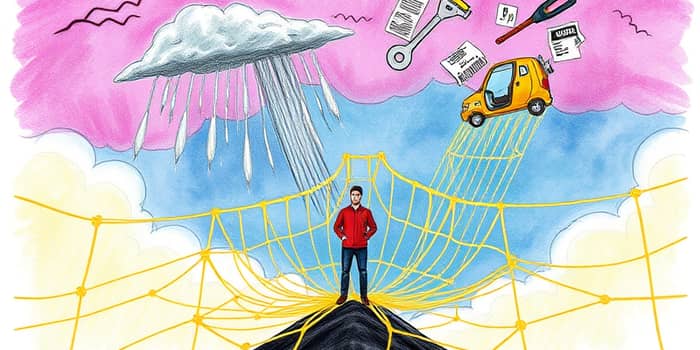When life throws curveballs, having an emergency fund can mean the difference between financial stability and crippling debt. An emergency fund is more than extra money—it’s a buffer against financial stress that empowers you to face the unexpected with confidence.
What Is an Emergency Fund?
An emergency fund is a dedicated savings account set aside exclusively to cover unexpected expenses. It differs from routine budgets and planned costs by existing solely for unforeseen life events.
- Job loss or income interruption
- Unforeseen medical bills
- Essential home or car repairs
- Family emergencies (travel, health, etc.)
This fund is not intended for vacations, impulse purchases, or routine upgrades. Rather, it is your financial cushion when reality bites.
Why Is an Emergency Fund Important?
Without an emergency fund, many households rely on credit cards or high-interest loans, leading to mounting balances and long repayment periods. Having cash on hand protects against these pitfalls and offers multiple advantages.
Acts as a financial buffer, shielding you from high-interest debt when emergencies strike. Instead of scrambling for a loan, you tap your savings and maintain control over your finances.
Avoids reliance on credit, preserving your credit score and preventing burdensome interest charges. This also prevents the temptation to withdraw from retirement accounts prematurely.
Enables bigger life decisions, such as changing careers, taking medical leave, or launching a side business, without fear of immediate financial collapse. It also provides peace of mind during turbulence.
How Much Should You Save?
Experts typically recommend setting aside three to six months of living expenses. Calculate your essential monthly costs—rent or mortgage, utilities, groceries, insurance, transportation, and debt minimums—and multiply by your target months.
Vanguard suggests starting with a milestone of $2,000 or half a month’s expenses for immediate shocks, then ramping up to a three- to six-month target based on household needs. For a family spending $5,000 per month, this could mean saving $15,000 to $30,000.
Real-world statistics illustrate the savings gap in the United States:
- Only 46% of Americans can cover three months of expenses.
- 24% have no emergency savings at all.
- 27% say they have enough for six months of expenses.
Generation matters: only 10% of Gen Z report having six months’ reserve, compared to 41% of Baby Boomers.
Where to Keep Your Emergency Fund
The ideal home for your emergency reserves is a high-yield savings account. It must be easily accessible, FDIC or NCUA insured, and offer competitive interest rates. Avoid investments with withdrawal penalties or volatility.
How to Build (and Maintain) One
Establishing an emergency fund takes discipline and consistent effort:
Automate your savings by directing 5–10% of each paycheck into your emergency account. This ‘pay yourself first’ approach ensures growth without relying on willpower alone.
Start with small milestones—the first $500 or $1,000 goal can build momentum. Celebrate these achievements to stay motivated.
Regularly review your budget and trim discretionary spending—subscriptions, dining out, or entertainment—to free up additional savings capacity even in lean months.
After tapping your fund for a legitimate emergency, replenish it promptly to restore your safety net.
When and How to Use Your Emergency Fund
Use this fund only for unavoidable, urgent, and necessary expenses—not planned vacations or impulse buys. Common triggers include job loss, sudden medical or dental bills, car breakdowns, home repairs, or unexpected travel for family crises.
Define what constitutes an emergency in writing: clarity prevents misuse and ensures funds remain available when truly needed.
Downsides, Risks, and Alternatives
Maintaining a large cash stash can lead to missed investment returns and may lag behind inflation. However, lacking this cushion exposes you to far greater risks: high-interest debt, asset liquidation at inopportune times, or financial ruin during a crisis.
Alternatives such as credit cards, payday loans, or early 401(k) withdrawals carry significant costs and should be considered only when no other option remains.
Who Needs More (or Less) Saved?
Current Trends and Challenges
Only 40% of people feel comfortable with their emergency savings. Geographic and generational disparities persist, with younger adults and residents of the South and Midwest lagging behind national averages.
Quick Tips and Best Practices
- Set clear, realistic savings goals and review them annually.
- Prioritize your emergency fund over extra loan or credit card payments.
- Define what qualifies as an emergency in writing to avoid misuse.
- Adjust targets as life circumstances change—marriage, children, or career shifts.
Creating and maintaining an emergency fund demands patience and consistency, but the payoff—true financial resilience—is immeasurable. Start today, protect tomorrow.
References
- https://www.mycvcu.org/blog/importance-of-building-an-emergency-fund
- https://www.bankeasy.com/personal/customer-resources/what-is-a-good-amount-for-an-emergency-fund
- https://www.northshorebank.com/about-us/connecting-with-you/budgeting/pros-and-cons-of-having-an-emergency-fund
- https://www.nerdwallet.com/article/banking/emergency-fund-calculator
- https://www.nerdwallet.com/article/banking/emergency-fund-why-it-matters
- https://www.bankrate.com/banking/savings/emergency-savings-report/
- https://investor.vanguard.com/investor-resources-education/emergency-fund/why-you-need-one
- https://www.wellsfargo.com/financial-education/basic-finances/manage-money/cashflow-savings/emergencies/










